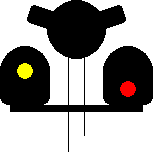|
|
|
|
|
|
|
|
|
Position light 'Toton' signals (see [10.13 - 10.16]) were provided as hump signals at most of the new mechanised marshalling yards that were brought into service during the 1950s and 1960s under the British Railways "Modernisation Plan" to handle large volumes of freight traffic. Some of these signals were double-sided. The hump signals at certain marshalling yards in the Eastern and North Eastern Regions had 'extended indications' to allow faster movements towards the hump. At these places, three white lights at 45° (see [10.15]) meant "normal humping speed", and three white lights vertically displayed (see [10.16]) meant "proceed to top of hump at faster than normal humping speed". If a slower humping speed was required, the driver could be verbally informed by radio.
At several marshalling yards in the London Midland and Scottish Regions, a series of additional hump signals was installed along the reception sidings to repeat the indications shown by the main hump signal. Since only one train could be propelled over the hump at a time, these additional signals were designed to apply to either of the two sidings between which they were situated. For the "hump slow" indication, the diagonal white lights were displayed at opposite angles of inclination (see [10.14 & 10.15]), depending on which siding the indication was applying to. Wing application lights (sometimes referred to as "ears") were attached to the sides of these hump signals [10.22 & 10.23]. Any aspect displayed was applicable to the siding on the same side as the illuminated application light. For consistency, a single application light was sometimes provided on a hump signal that applied only to one siding.
 |
 |
|
[10.22] Left-hand Application Light (e.g. signal showing 'hump normal').
Area: London Midland and Scottish Regions Usage: Medium Status: Historical |
[10.23] Right-hand Application Light (e.g. signal showing 'hump slow').
Area: London Midland and Scottish Regions Usage: Medium Status: Historical |
|---|
Some of the hump signals (usually those closest to the hump on each reception siding) had 'train engine release' signals mounted below the position light head and offset to either side of the signal post. Each train engine release signal took the form of a miniature two-aspect colour light signal. A red aspect [10.24] meant "stop", and a green aspect [10.25] meant "proceed as far as the line is clear towards the next signal". These signals marked the stopping position for arriving trains. Once the locomotive had been uncoupled from its wagons, the relevant train engine release signal was cleared to allow it to run forward towards the hump and away from the reception sidings, usually onto a line that bypassed the hump. The application lights attached to any hump signal (see [10.22 & 10.23]) were not lit in conjunction with the train engine release signals. Both train engine release signals were extinguished while the hump signal above was illuminated. For consistency, the train engine release signal was offset to the appropriate side of any hump signal that applied only to one siding [10.26].
 |
 |
 |
|
[10.24] Hump Signal with two Train Engine Release Signals (both train engine release signals showing 'stop').
Area: All Areas Usage: Medium Status: Historical |
[10.25] Hump Signal with two Train Engine Release Signals (e.g. train engine release signal applicable to line on right showing 'proceed').
Area: Toton Usage: Low Status: Historical |
[10.26] Train Engine Release Signal (e.g. green aspect; applicable to line on left).
Area: All Areas Usage: Medium Status: Historical |
|---|
In later installations, train engine release signals displayed a yellow aspect [10.27] instead of green. In some cases where a hump signal applied only to one siding, the train engine release signal was placed directly beneath the hump signal [10.28]. Some later train engine release signals were in the form of a position light shunting signal (see [4.74] and [4.87]).
 |
 |
|
[10.27] Hump Signal with two Train Engine Release Signals (e.g. train engine release signal applicable to line on left showing 'proceed').
Area: All Areas Usage: Medium Status: Historical |
[10.28] Train Engine Release Signal (e.g. showing 'proceed').
Area: All Areas Usage: Low Status: Historical |
|---|
A position light shunting speed indicator and a double-sided repeater were provided at York No. 1 Down South Yard (Hump Sidings) in September 1955, applicable to movements on the Hump Shunting Line. The "proceed to hump summit at normal shunting speed" aspect was three white lights in the upper quadrant (see [10.15]). The aspect meaning "proceed smartly towards hump summit" was three white lights vertically displayed (see [10.16]). The 'stop' aspect comprised red lights on either side of the white pivot light [10.29], whereas a diagonal line of lights coloured green-white-green [10.30] meant "set back from the hump summit".
 |
 |
|
[10.29] Position Light Signal showing horizontal indication (red and white lights).
Area: All Areas Usage: High Status: Obsolescent |
[10.30] Position Light Signal showing diagonal indication (green and white lights).
Area: York Usage: Low Status: Historical |
|---|
|
Some of the special semaphore shunting signals on the North Eastern Region (see [10.6 - 10.8]) were replaced by Toton signals in the late 1950s. The angles and colours of the lights in each new indication corresponded with those of the old signals. The 'stop' aspect comprised red lights on either side of the white pivot light, in a horizontal line (see [10.29]). Three white lights were displayed at 45° (see [10.14]) for "draw forward", and green lights on either side of the white pivot light, also at 45° but inclined the opposite way [10.31], for "set back slowly". Some of the new signals were additionally able to display three white lights vertically (see [10.16]), meaning "set back". |
|
Margam Yard, which opened in March 1960, featured a form of cab signalling with a three-position indicator fitted inside the cab of the hump locomotive. This presented the driver with an indication comprising three white lights inclined at an angle corresponding to the aspect shown by the hump signal, avoiding the need for additional hump signals to be installed along each of the reception sidings. Any change of indication was accompanied by an audible signal.
|
When the Glasgow Central station area was resignalled in January 1961, special stencil type banner signals were provided on all the platform starting signals. These normally displayed no indication. When the main signal cleared to a yellow aspect (see [2.106]) and the banner was illuminated [10.32], it signified that a miniature yellow 'proceed' aspect (see [4.86]) was being exhibited at the next main signal. The banner indication helped to ensure quick clearance of the platform line, particularly if the movement was being propelled. The banners were removed from the signals in September 1971. |
|
"Merry-Go-Round" (MGR) operation involves long block trains running between terminals to transport large volumes of minerals, especially coal. Special signals, which are sometimes referred to as 'creep signals', evolved to manage the loading and unloading of these trains in a rapid but carefully controlled manner using locomotives fitted with slow speed control. Usually, a series of identical signals are located at intervals along the line used for loading or unloading, all displaying the same indication at the same time. They are positioned in such a way that the driver always has a clear view of at least one signal in normal visibility conditions.
The first trials of the MGR system took place at West Burton Power Station (Eastern Region), using creep signals in the form of Toton signals that displayed three white lights horizontally (see [10.13]) for "stop" and three white lights vertically (see [10.16]) for "proceed". The signals came into use in October 1964, and the MGR trials commenced in the following year. The 'stop' aspect of the creep signals was altered in 1966 to show red lights on either side of the white pivot light (see [10.29]).
Tinsley Marshalling Yard, near Sheffield, opened in April 1965. At this site, the position light hump signals displayed just two indications, "stop humping" [10.33] and "proceed" [10.34], both indications comprising a line of five white lights. Cab signalling similar to that used at Margam Yard was also provided at Tinsley Yard. The indications displayed by the three-position indicator inside the cab did not necessarily repeat those shown by the two-position lineside hump signals.
 |
 |
|
[10.33] Position Light Signal showing horizontal indication (five white lights).
Area: Tinsley / Fiddlers Ferry Usage: Medium Status: Historical |
[10.34] Position Light Signal showing vertical indication (five white lights).
Area: Tinsley / Fiddlers Ferry Usage: Medium Status: Historical |
|---|
|
In May 1965, a double-sided indicator was positioned on a gantry above the Sudbury Arrival Lines at Wembley to repeat the two semaphore hump signals. The indicator displayed an illuminated letter "H" [10.35] when the hump signals were in the 'off' position. |
|
From around the mid-1960s, changes in goods traffic patterns rendered the large mechanised marshalling yards redundant.
Colour light signals with special meanings attached to their aspects were provided at Bevercotes Colliery (Eastern Region) to control the movement of trains through the bunker while the wagons were being loaded with coal. A green aspect (see [10.12]) meant "draw forward at ½ mph", a yellow aspect (see [10.10]) meant "prepare to stop", and a red aspect (see [10.9]) meant "stop immediately". A red aspect together with a flashing yellow aspect [10.36] meant "reverse until flashing yellow is extinguished".
The Scottish Region initially also used colour light signals with special meanings to control the loading and unloading of MGR coal trains at various sites. A green aspect (see [10.12]) meant "proceed forward". The train may proceed within normal visibility limits. A yellow aspect (see [10.10]) meant "proceed forward with caution at ½ mph". Slow speed control needs to be engaged, and the driver must be prepared to stop. A red aspect (see [10.9]) meant "stop immediately, even though not at signal". At certain installations, signals could display a flashing red aspect [10.37]. When this was displayed, the driver was required to stop the train (if it was moving) and set back at ½ mph. At Monktonhall Colliery, the flashing red aspect was followed by a short steady red aspect on which the driver took no action. This was followed by a flashing yellow aspect [10.38] lasting about 6 or 7 seconds, then a steady yellow aspect. The train must then stop reversing and obey the yellow aspect. Not every signal was capable of displaying all of these aspects.
 |
 |
 |
|
[10.36] Colour Light Signal showing Red with Flashing Yellow Aspect.
Area: Bevercotes Colliery Usage: Low Status: Historical |
[10.37] Colour Light Signal showing Flashing Red Aspect.
Area: Scottish Region Usage: Medium Status: Historical |
[10.38] Colour Light Signal showing Flashing Yellow Aspect.
Area: Scottish Region Usage: Low Status: Historical |
|---|
On the London Midland and Scottish Regions, illuminated indicators displaying the words "set back" [10.39] were provided to control movements setting back into certain sidings, at locations where handsignals cannot be observed. Equivalent indicators on the Eastern Region displayed the words "shunt back" [10.40]. If the indication was extinguished, the setting back movement had to stop immediately.
 |
 |
|
[10.39] "Set Back" Indication.
Area: London Midland and Scottish Regions Usage: Low Status: Uncertain |
[10.40] "Shunt Back" Indication.
Area: Eastern Region Usage: Low Status: Uncertain |
|---|
|
|
|